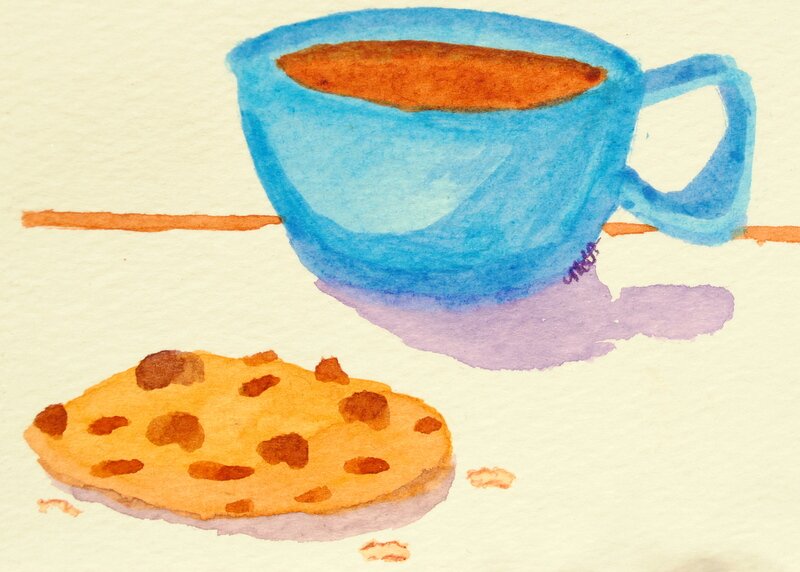This is the first in a new series "what is an artpreneur?". Today I look at traditional ways of selling art that many artists still practice today, postcard marketing and thoughts on why people loved my Grandfather's watercolors.
It was 5:30 when we pulled into the dark street. The shops and gallery windows were dark. Down the street a truck pulled in and parked.
The man jumped out and raised up a quiet hand in a wave. The wind was blowing fairly steadily. I zipped up my jacked and stood next to the van. Grandpa pulled out the large easy-up canvas tent. We put it up, pushing the metal frame until the click sound ensured it was locked in place. Next came the panels- 8 foot high fabric covered structures to hang and show the art work.
Grandpa searched in the back of the van for the forest green toolbox that traveled with him for the past several decades. "I hope I brought those weights," he said as he dug out the weight attachments in the bottom of the tool box. The weights were found tucked under a seat and applied to the bottom of the canvases. They stopped rattling despite the gusty weather.
Welcome to the world of art shows. It's high on work and short on glamour.
I grew up in watching my grandparents run their art business. They handled the business as a team: Grandpa was the artist and Grandma ran the business and money part. For decades they traveled together to art shows and promotional events. In later years one of my uncles began to help with the art shows, making the business somewhat of a family affair.
Grandpa painted amazing realistic watercolors featuring landscapes and architecture. Grandpa painted many different scenes but the majority of his work focused on two geographical locations: Europe and California.
Paintings from California included shots of homes in the abandoned town of Bode, the trails around Central California, harbor scenes from San Francisco, China Town and other beach. Grandpa traveled to Europe consistently to study architecture, landscapes and collect material for his European paintings. Over the years collectors bought out his collections from Spain, Belgium, England, France, Greece and Italy.
Grandpa and Grandma went to hundreds of weekend shows over the years. They talked with new visitors and established clients. I was thrilled to come to their shows and even help them set up and tear down on different occasions. It was an unforgettable experience.
Art is a unique business. It's hard to know what people will buy.
The connection between the art and the recipient is often made in the heart and the mind. Marketers will say that you can "niche your audience" and to some extent, one can. But there are some things that connect with people that can't be measured.
The heart is like that- it is unpredictable and mysterious.
It's hard to hook up an analytics code to somebody's heart and analyze what touches them and what doesn't.
Nonetheless, Grandpa knew people and he listened to what they liked. He could smell the difference between admirers and people who were really interested in buying. Grandpa appreciated the admirers but it was art buyers and collectors that paid the bills! He spent time listening to them, cultivating relationships, occasionally doing commissioned work and building a body of work he knew they were interested in.
There was no one type of person who liked Grandpa's work. People of all backgrounds and histories loved Grandpa's work. Some had walked in Portofino, Italy and his scenes invoked strong memories. Other people dreamed of visiting the places Grandpa painted or fell in love with the exquisite detail of the artichoke blossoms or birch trees in the fall.
Marketing Artwork
Grandma made a mailing list and collected the names and addresses of the people who visited. Each year she sent out big stacks of postcards hand addressed to buyers and interested parties.
When I say "stacks" it was literally stacks and stacks of postcards. Like hundreds of postcards.
I would visit and Grandma would sit and personally address the cards one by one. On one side the postcard would highlight some of the new collection Grandpa had painted during the off-season months. This would be called by today's marketers as "lead generators."
At the show new people would come, visit and buy. Loyal customers returned to see what new paintings Grandpa had created. The most loyal buyers might call to "grab" an original before someone else got it.
Grandpa and Grandma were savvy business people. They met the people with different price points.
- Original paintings came in all sizes and were the most expensive
- Half and quarter sheet lithographs were replications of the originals. These cost significantly less than the originals.
- The smallest size of the most popular paintings was a 11x14. These paintings were sold for a single price or a "deal" when two or more were purchased. (I remember Grandpa telling me some shows were saved by the people who bought 'out of the bin').
- Stationary. Some of the images of the most popular paintings were transferred to stationary. I loved getting "art stationary" letters from Grandma, an avid letter writer. Grandpa didn't really sell these. Grandma used them for marketing and sent letters on them.
- Giclee prints.
- Giclee on Canvas
As advances in technology came, Grandpa opted to make giclee (pronounced jee-clay) prints through my uncle's print shop. Giclee prints have a higher ink resolution so the print could come out looking almost as good as the original. Another benefit- Grandpa could print as few or many as he needed. When he and Grandma ordered lithographs the print company required several hundred to be bought at a time. (Imagine having to guess which prints would be popular and in demand for years to come!)
Later in the business Grandpa began to print watercolors on canvas. I loved these- no frames, nothing to break- just gorgeous art wrapped around a canvas. They were big and beautiful. They were very light weight and looked so high-end.
Grandpa and Grandma ran their art business much like several other fine artists. Whether sculptors, painters, etchers, photographers or other fine art, artists sold their art through shows and galleries.
Two Major Game Changers
Two changes changed the direction and destinies of artists:
1. 2008- the economy crash
2. More people buying, searching and selling on the Internet
With the fall of the economy in 2008 and the rise of the internet, artists began to see a shift in sales and in the way things were sold.
Many artists have had a challenging time transferring their art to online selling. Others adapted, started websites and blogs and started sharing their art and selling on sites.
Grandpa was approaching the end of his show days. He wasn't slowing down his artwork- he painted 7 days a week. He just got tired of shows. He didn't need the money and in his words, "I want to do art for me." (After 50+ years painting for other people I guess he deserved the break!") He spent his last years painting big, bold, beautiful abstract art. He also made fine art mobiles of fish and butterflies (separately, not together) and had a growing list of different art he wanted to create. His mind did not stop working.
Grandpa was a prolific artist.
In the prime of his activity, Grandma was marketing his art work through keeping in contact with collectors, mailing out thousands of postcards and building up the list of people buying and interested in Grandpa's work.
You can be prolific, have a huge body of work- books, photographs, paintings- but if you don't have a marketing plan it probably won't be successful.
Our plans can be as different as apples and oranges- the important element is the plan. Grandma's plan and system was communication through business cards and an annual home show. It worked very well.
In some ways, the art business is the same. People still attend different events, trade shows and art fairs. Artists can and should collect the names of people who are interested in their work. "Build a list" is a popular online term but a notepad and a pen at a convention works just as well.
But there are some key differences today's artpreneur needs to do to promote their art, move it in front of their audience and steadily establish a presence (and earn an income).
This is the world of what I refer to as the "traditional art business for the solo artist."
Was Grandpa an artpreneur? No, not really. He could have done more with his art in the arena of marketing but he had no desire to. He was a master painting. He loved to paint. It was his world and focus. Although he was asked to teach classes and do other things he chose to focus on his painting.
Some artists continue to make a living like this today. But for many creatives who want to create income from their creative incomes there will need to be a shift in the way the modern day artpreneur thinks, shares and sells.

Grandpa and I in his studio- 2010
Later this week I'll share another aspect of the creative world: the world of craft fairs. For a brief period of time I owned a candle business where I made and sold candles. I also taught candle-making classes. Tune in tomorrow for "10 Lessons I Learned from Running a Candle Business (and what I would do differently if I started today)"
Do you consider yourself to be an artpreneur? Are you currently selling your work in traditional spaces such as art shows and galleries?




Leave a Comment